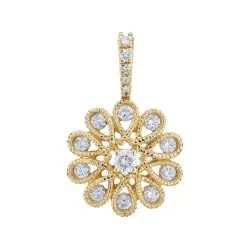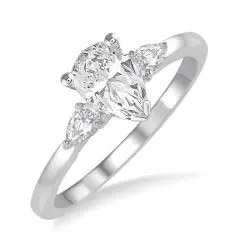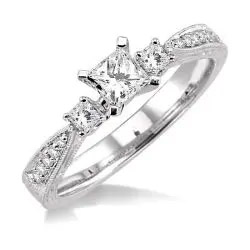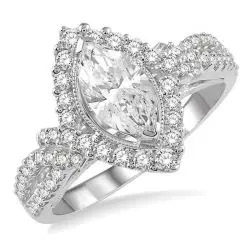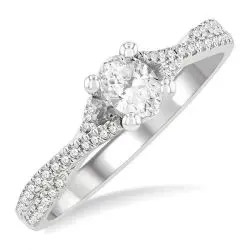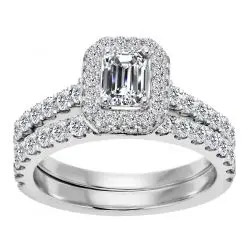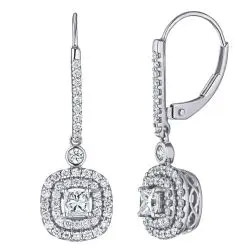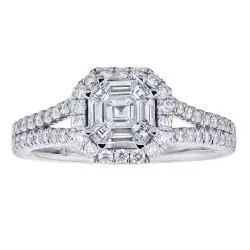Like everything else in this world, when humans desire something, they'll pursue it relentlessly, often transforming it into something truly remarkable. Diamonds perfectly exemplify this tendency. Much like fire, we've mastered these precious gemstones, delving into every conceivable facet of their fashion potential—pun intended. Our fascination with diamonds has spurred the development of various cuts and shapes, ushering in an era of unparalleled elegance and diversity in jewelry.
What is a diamond shape?
A diamond's shape refers to its inherent or deliberately altered physical form and appearance. Typically, these shapes or cuts are meticulously crafted using precise measurements to accentuate the stone's natural beauty. Throughout history, skilled diamond artisans have dedicated countless hours to perfecting these cuts, aiming to enhance two key aspects: scintillation—the mesmerizing sparkle—and brilliance—the captivating brilliance of its light reflection capabilities.
Why have different diamond shapes
Over the years of use in the fashion and jewelry industry, diamond consumers wanted to find ways to market the fabulous stone in new and interesting ways. One way to do that was to cut the stone into different shapes and sizes to allow for a greater amount of customization, thus reaching a larger audience of buyers. With more customization options, jewelers found new ways to market the stones.
Since dozens of different shapes were discovered and created, there was a need to simplify the options. Eventually, they were split into two categories: fancy diamonds and round diamonds, making the classifications a little easier for shoppers.
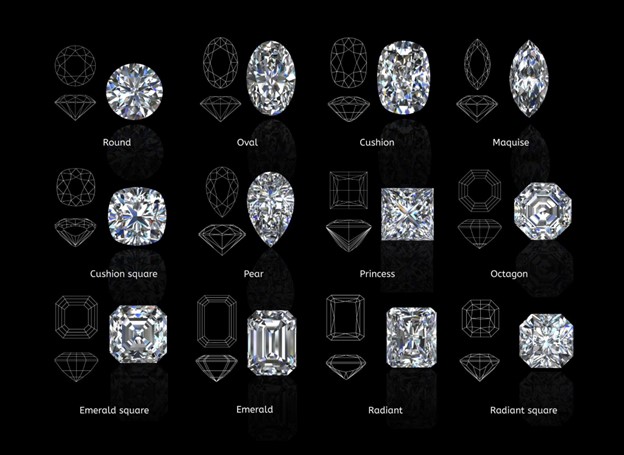

Dawn of the Diamond Shapes
When you close your eyes and think of a diamond, most people envision that iconic round shape, typically adorning earrings and rings. However, many other diamond shapes have been created throughout our history. Below, explore the origins of each diamond cut and what makes them so unique. Also, see some wonderful example settings that feature that specific shape that you can pick up for yourself at our stores!
Round
Everyone loves the classics; round shapes are as traditional as it gets. It's the barebones of diamond cuts, the Goldilocks special, the safe bet that you will never be disappointed with. Round-cut diamonds have existed in almost every form of diamond jewelry, this is most likely due to their simplicity and natural appearance. They have an eye-pleasing symmetry that makes those facets pop! It's no wonder it has become the staple of engagement rings all across the world.
Originating in the later 1700s, the round-cut diamond found its way into jewelry around the globe. However, it didn't truly gain its bearings until around 1919 when it was fully developed by Marcel Tolkowsky. Tolkowsky created a special mathematical formula/ruling that maximized the symmetry and beauty of the discovered round-cut shape. Because of this optimization, the form quickly became regarded as the perfect shape or the “rightful” shape of the diamond. Something about breaking down the facets mathematically just made sense, and everyone was on board.
Here you can find dazzling round-cut diamonds fit for any of your engagement or wedding needs.
If you have other ideas here is an example piece that we offer featuring the staple round diamond shape.
Diamond Round Scalloped Shaped Open Weave Milgrain Pendant
This example truly optimizes the symmetrical potential that round-shaped diamonds have to offer. This pendant features 11 wonderful round-cut diamonds and some oval-shaped diamond sidekicks. It's a great option for those who love bright and shiny diamond necklaces. It’s also a great pick up for those who love maximizing yellow gold jewelry!
Pear
The pear-shaped diamond, often referred to as the "teardrop" due to its distinctive silhouette, has a rich history that dates back to the 15th century. This unique cut, originally known as the "pendeloque," combines the round brilliant and marquise cuts, featuring a rounded end that tapers to a point. It was pioneered by Flemish polisher Lodewyk van Bercken, who invented the diamond-polishing wheel, which allowed for more precise and symmetrical faceting. This innovation not only increased the diamond's brilliance but also set the stage for the pear cut's enduring popularity.
The pear cut’s elegant shape makes it a versatile choice for various jewelry styles, from engagement rings to pendants and earrings. Its design, characterized by balanced proportions and precisely cut facets, enhances its light performance, creating a stunning sparkle spectacle that thrills any audience.
Below is a great example of a pear-shaped diamond piece that would fit nicely into your daily aesthetic.
Pear Shape Diamond Engagement Ring
Sharp and elegant, like you or your loved one's personality, this ring epitomizes what it means to don a pear diamond ring. Its striking angles and points draw attention to your hands and the diamond ring. As an engagement ring, this masterpiece will remind others that you are certainly taken; there is no missing that eye-catching pear diamond perfection.
Princess
The princess-cut diamond, known for its distinctive square or rectangular shape with pointed corners, is a relatively recent innovation in the world of gem cutting. This cut was initially developed in the 1960s by Arpad Nagy, who sought to create a diamond that could rival the brilliance of the traditional round cut. Nagy's invention, originally termed the "profile cut," combined the elegance of the square shape with a complex faceting pattern that maximized the stone's light performance and sparkle.
By 1979, the princess cut had gained significant traction, becoming a favored choice among jewelry enthusiasts and quickly rising in popularity. Gaining most of its popularity in the 80s and 90s, the shape boasts a unique blend of modern aesthetics and nostalgia. Its exceptional brilliance appeals to those looking for an eclectic yet elegant look. The princess cut's sharp, uncut corners and versatile shape make it an ideal option for engagement rings and other statement jewelry, securing its place as one of the most beloved diamond cuts of the late 20th and present.
Here is an example of a princess cut ring that we think highlights its true colors
Past Present & Future Diamond Princess Cut Engagement Ring
Fitted with three elegant princess-cut diamonds, you’re sure to know you’re representing this special cut. Fit for any lover, this ring is the epitome of everlasting bonds and loyalty. Additionally, the three princess stones symbolize that you will be their royalty in any reality: past, present, or future! Lastly, the ring is also embellished with wonderful round-cut diamonds to contrast the angularity of the princess-cut centerpiece diamonds.
Marquise
The marquise-cut diamond, known for its elongated shape and pointed ends, traces its origins back to 18th-century France, particularly during the reign of King Louis XV. Legend has it that Louis XV commissioned this distinctive cut to resemble the shape of the lips of his lover, the Marquise de Pompadour. This romantic inspiration gave the marquise cut not only its name but also an air of royalty and poshness that has endured throughout history.
Inspired by the allure of lips, the marquise cut embodies attraction and intimacy. However, the unique silhouette of the marquise cut offers numerous practical and aesthetic advantages as well. Its elongated form and pointed tips create the illusion of a larger diamond, maximizing the perceived size and brilliance of the stone. Additionally, this shape has a slimming effect on the fingers, making them appear longer and more graceful. Over the centuries, it has remained a popular choice for those seeking a diamond that stands out with its distinctive attention-grabbing effect.
The marquise diamond cut shape makes it suitable for just about any diamond jewelry adornment; however, it looks its best in rings due to its obvious symbolism and romantic curves.
Marquise Shape Semi-Mount Diamond Engagement Ring
This expertly embellished diamond ring has a distinct movement and gracefulness you don't find in everyday rings. Like flowing water, the side-stone diamonds seem to cascade around the Marquise centerpiece as if they were rocks on the riverbed. It creates a pleasing movement and to emphasize the massive marquise diamond nestled comfortably in the center of the piece.
Oval
Oval-shaped diamonds have been around for quite some time, but they gained significant popularity in the 1960s when they were introduced by the Russian-born diamond cutter, Lazare Kaplan. Since then, oval-shaped diamonds have surged in sales, especially for engagement rings and other jewelry pieces. This might be due to their elegant appearance and ability to create the illusion of longer, more slender fingers for the wearer. As an elongated and elegant version of the classic round diamond, it has a gracefulness that allows it to take up significant space on rings and looks nice when paired with other diamonds in the round category. Residing in the round category itself, it's very geometric and easy to look at. Due to its popularity, it makes its way across many different diamond jewelry categories, much like its "round diamond" shaped brother.
Oval Shape Diamond Engagement Ring
A prime example of the power of an oval-cut diamond is represented here in this grandiose, curvy, and spectacular engagement ring. Almost as gorgeous as your significant other, this ring truly lets that oval shape shine. This time you can find dozens of round-shaped diamonds on the sidelines, making the oval feel even more elegant and dainty. If you want an engagement ring that has character and brings out the natural beauty of anyone, then this is the oval-shaped diamond ring to get!
Heart
Who wouldn't want a heart-shaped diamond? You get the symbolism that has grown for thousands of years, and you get a cute diamond shape. It's the diamond shape of romance and the cut of an everlasting bond. While the exact origins of this iconic shape have numerous different trails from ancient history, it gained popularity during the 16th century in Europe. The heart shape, with its symbolic representation of love and affection, became a favored choice for gemstones, particularly in sentimental jewelry pieces.
However, it wasn't until the late 20th century that the heart-shaped diamond cut truly flourished.
With advancements in gem-cutting technology, diamond cutters were able to refine the heart shape, enhancing its brilliance and symmetry. This led to a resurgence in demand for heart-shaped diamonds, especially for use in engagement rings and other romantic jewelry.
Emerald
The emerald-cut diamond has a rich history intertwined with its origins and creator. This distinguished cut is said to have originated in the 16th century, crafted specifically to showcase the beauty of emerald gemstones. It was initially designed with step-cut facets to highlight the emerald's clarity and color, allowing for a mesmerizing display of its inner radiance. While its exact creator remains unknown, the emerald cut's roots can be traced back to gemstone cutters in Europe who sought to bring out their best.
As the centuries passed, diamond cutters recognized the allure of the emerald cut for diamonds as well. By the early 20th century, it had transitioned into a favored choice for diamonds, prized for its understated elegance and timeless sophistication. The emerald cut's rectangular shape with cropped corners and open table became synonymous with classic beauty, making it a sought-after option for engagement rings and high-end jewelry pieces. Today, the emerald-cut diamond continues to captivate with its refined aesthetics, serving as a symbol of unyielding beauty and unparalleled craftsmanship.
Refined and sophisticated the emerald-cut diamond upgrades any ring or accessory to the next level. Here is an example that does exactly that!
14k White Gold Emerald Cut Diamond Halo Engagement Set
This 14-karat white gold and emerald cut diamond ring has a classy and powerful look. There is something about the rectangularity of the emerald diamond cut that makes you feel more confident and resolved. It's a ring fit for that lucky someone in your life who is bold and not afraid to shine bright. A perfect combo of grit and beauty!
Cushion
The history of the cushion cut diamond is a journey through centuries of refinement and innovation, with its roots dating back to Brazil and India in the 18th century. Originating as the "old mine cut," due to the shape in which they were found in the mines, this distinctive shape resembled the cushioned furniture of the time, featuring rounded corners and large facets. Initially designed to maximize the diamond's brilliance and fire, the cushion cut quickly gained popularity among royalty and nobility for its luxurious appearance and romantic allure.
As diamond-cutting techniques evolved, so did the cushion cut. By the late 19th century, advancements in gem cutting led to the development of the modern cushion cut, characterized by a more symmetrical shape and enhanced sparkle. This updated version became a favored choice for engagement rings and high-end jewelry, prized for its timeless elegance and sophistication. Today, the cushion cut diamond remains a symbol of luxury and refinement, treasured by those who appreciate its classic charm and exceptional beauty, with its origins tracing back to the diamond mines of Brazil.
Diamond Cushion Cut Double Halo Leverback Earrings
This cushion-cut earring set exhibits all the characteristics of a setting that will make you or your loved one ecstatic. From the intricate white gold lattice on the back of the earrings to the surrounding double diamond halo around the centerpiece cushion diamond, you get the whole package. And don't forget the diamonds that ascend up and down the clasp, adding that extra sparkle and bling!
Radiant
The radiant cut diamond, known for its vibrant sparkle and unique shape, was introduced in 1977 by expert diamond mason Henry Grossbard. Grossbard aimed to combine the elegance of the emerald cut with the brilliance of the round brilliant cut, resulting in a diamond that would exhibit exceptional fire and scintillation. The radiant cut features a distinctive combination of brilliant-cut and step-cut facets, arranged in a square or rectangular shape with soft cut corners. This innovative facet pattern maximizes the diamond's light performance, creating a dazzling display that has dazzled jewelry buyers since its creation.
At first, the radiant cut gained popularity for its versatility and ability to enhance the inherent beauty of various diamond types, including those with inclusions or lower color grades. Its unique design helps to mask imperfections and highlight the stone's clarity and color. Now it has become a modern staple in all forms of jewelry, especially wedding and engagement rings.
Asscher
The Asscher cut, also referred to as the square emerald cut, is renowned for its distinctive stair step like design and cropped corners. This unique diamond cut was pioneered in 1902 by the Asscher Brothers, Joseph and Abraham Asscher, who were well known jewelers based in Amsterdam. Their family already had a long history in the diamond industry and it made sense that one of them would coin a unique cut eventually. Their creation stood out during the early 1900s, characterized by its precise geometric form and mirror-like facets which highlighted the diamond's luster and brilliance.
During its dawn, the Asscher cut gained significant attention, particularly within the Art Deco movement of the 1920s and 1930s. This era celebrated clean lines, symmetry, and bold geometric shapes, all of which are hallmarks of the Asscher cut. Its ability to embody the essence of Art Deco made it a favored choice among connoisseurs of fine jewelry. However, as the decades progressed, the popularity of the Asscher cut diminished.
The early 2000s witnessed a remarkable resurgence of the Asscher cut, thanks to a growing appreciation for vintage and retro styles. This resurgence was driven by a combination of celebrity endorsements and a broader ideas toward unique, individualized jewelry choices. Modern adaptations of the Asscher cut often incorporate more precise and refined cutting techniques, enhancing its brilliance and appeal. Its historical charm continues to captivate those with a passion for a classic and geometric aesthetic.
A great example of a well-made ring featuring the Asscher cut style is this one below!
Diamond Asscher Shaped Composite Cluster Split Shank Engagement Ring
Adorning a wonderfully perfect Asscher cut diamond, this setting speaks to those who desire old-fashioned elegance. This Asscher cut engagement ring features dozens of diamonds on a split shank style that is highly geometric and mathematical, yet it possesses a slight elegance that nods to classical beauty. If you want to wear and show off an Asscher cut diamond ring, one that exemplifies the Art Deco movement, then this is the perfect choice!




